
Sign up for Editor’s choice. Get more investing insight like this in our weekly newsletter – Editor’s choice.
The foreign exchange (FX) market has been stealing the limelight from stocks in recent weeks. A surge in the US dollar (USD) has caused shock waves in global currency markets.
Here’s why and what impact the FX market volatility can have on your investments.
This article isn’t personal advice. If you’re not sure whether a course of action is right for you, ask for financial advice.
What to make of the US dollar domination
The story starts with the world’s most important currency, the US dollar. It’s the most traded currency in the world, and it’s central to the global financial system.
The latest Bank for International Settlements (BIS) triennial FX market survey from 2022, showed that FX trading averaged $7.5tn per day. The USD maintained its dominant position, being on one side of 88% of all FX trades, and 44% of global turnover of interest rate derivatives.
This means that the dollar dominates trade flows, as well as a big portion of all loans, hedging and other investment activity. If trading is dominated by the dollar, then the dollar controls the world’s riches.
Because of its position in the global financial system, when the dollar moves, the world takes notice and it’s made a strong start to 2024.
It’s the best performing currency compared to all other G10 currencies. It’s more than 9% higher against the Japanese yen (JPY), and versus the euro, it’s 2.7% higher. The pound’s been the most resilient of the G10 so far this year, and even sterling is still lower versus the dollar by 1.8%.
The dollar is also the strongest performer versus all expanded major currencies apart from the Mexican peso, which moves closely with the dollar. It’s also higher against most emerging market currencies, including the Indian Rupee, the Thai Baht, and the Romanian Leu.
Almost everyone has seen their currencies plunging against the dollar, and this can have big consequences for some economies.
How does the dollar impact emerging markets?
Recent research from the International Monetary Fund (IMF) found negative spillovers from USD appreciation fall disproportionately on emerging market economies when compared to smaller advanced economies.
For example, a 10% increase in the value of the dollar decreases economic output in emerging market economies by 1.9% after one year. And the drag on growth can linger for two and a half years.
On the other hand, the impact of a strong dollar on advanced economies is much smaller, peaking at 0.6% of gross domestic product (GDP) and pretty much disappearing after a year.
Emerging market economies with anchored inflation expectations or more flexible exchange rate regimes tend to perform better when the dollar is stronger. But the effects of a stronger dollar spread by trade and financial flows.
Trade volumes tend to decline, with imports dropping more than exports – this is because imports of goods priced in USD, like commodities, get more expensive. They also suffer from worse access to credit, less capital inflows, tighter monetary policy, and weaker stock markets.
All of this adds to the pressure on growth in emerging market economies. The effects of this year’s dollar gain might be felt for years in the emerging world, and might also weigh on global growth.
Japan’s dollar headache
The strengthening dollar has also caused a major headache for Japanese officials. A 9% decline in the USD-JPY exchange rate so far this year has proven too much for Japanese authorities.
At the end of April, the USD/JPY exchange rate surged to just under 160 yen to the dollar. This was the weakest the JPY has been against the dollar for 38 years and was the culmination of two weeks of excessive losses for the Japanese currency.
The move to almost 160 was triggered by the Bank of Japan (BoJ) meeting on 26 April, when it pushed back on expectations that it would hike interest rates more aggressively this year.
USD/JPY long-term exchange rate
Past performance isn’t a guide to future returns.
Source: Bloomberg, 09/05/24.
The yen fell sharply after this meeting, with signs the BoJ was forced to directly intervene in the currency markets to stop the yen from falling further. This is a tactic some countries adopt to try and ‘protect’ a weakening currency.
If a central bank has enough FX reserves, then they can try and buy enough of their currency to lift it out of stagnation. The BoJ has $1.14tn in FX reserves, so it’s got a big war chest to try and defend its currency.
But this is an expensive endeavour, and it can be futile.
For example, the BoJ likely spent more than $22bn trying to prop up the yen in early May. However, it only boosted the yen by 3% against the USD and since then the yen has been subdued.
Instead, the direct intervention in the currency market caused the price of USD/JPY volatility to surge, which makes trading the Japanese currency more difficult.
As the BoJ is finding out, it’s tough to fight the onslaught of the USD.
Why is the dollar rallying?
There’s a wide gap in interest rates between the US and other countries. The Federal Reserve (Fed) started raising interest rates in spring 2022, lifting rates from close to 0% to 5.25-5.5% today.
The Fed is expected to be the last major central bank to start cutting interest rates. The market isn’t expecting the first Fed rate cut until September.
In contrast, interest rates in Japan are just above zero, and while the BoJ is expected to hike interest rates again, there’s currently only 18 basis points of hikes priced in for the rest of 2024. By the end of 2024, interest rates are still expected to be 4.62% higher in the US than they are in Japan.
The outlook for economic growth and inflation is strong in the US. This is also lending support to the US dollar.
For example, the Organization for Economic Cooperation and Development (OECD) expects the US economy to grow 2.6% in 2024, and 1.8% in 2025. This is a lot higher than the OCED’s predictions for UK, Japanese and Euro area growth. The OECD expects them to grow 0.4%, 0.5%, and 0.7% respectively.
When it comes to the FX market, a big interest rate differential, combined with a weaker growth outlook, could trigger currencies to fall against the USD. This is what happened to the Japanese yen.
The FX market often doesn’t move in isolation though. A strong dollar could send a chill through central banks in the emerging world and the developed world.
So far, the BoJ’s current account balance has taken a battering from trying to stem currency weakness. The question now is, how and when will the dollar weaken?
The easiest way to weaken the dollar is to narrow the interest rate differential between the US and elsewhere. However, with Japan raising interest rates at a snail’s pace, some emerging markets cutting interest rates, and the European Central Bank and Bank of England expected to cut rates later this summer, the US dollar might have further to go. There are no guarantees and only time will tell.
Kathleen Brooks is the Founder of Minerva Analysis, a market analysis company. Hargreaves Lansdown may not share the views of the author.

